|
Civilisations
rise. Civilisations fall. However, few civilisations have
risen and fallen quite as rapidly as Gallifrey does between
the Eighth Doctor novel The
Gallifrey Chronicles and the Last Great Time
War mentioned in the new TV series. Richard McGinlay pieces
together the disparate and seemingly contradictory evidence
from various media to propose what might have happened during
the build-up to the Time War...
The
decision by Russell T Davies, Doctor Who's chief writer
and Executive Producer, to destroy Gallifrey was not an attempt
to tie in with the continuity of BBC Books' Eighth Doctor
Adventures (EDAs), which had already put the planet out of
the picture in Peter Anghelides and Stephen Cole's The
Ancestor Cell back in 2000. Davies and BBC Books' then
Consulting Editor (now Creative Director) Justin Richards
arrived at their respective decisions independently, both
seeing the need to purge the series of the over-familiarity
and consequent lack of mystery of the Time Lords and return
some of the uniqueness to the Doctor's character.
 |
Initially
it appeared as though all of the Time Lords apart from the
Doctor had been destroyed, though Lawrence Miles' subsequent
EDA The
Adventuress of Henrietta Street suggested that
four Time Lords (referred to as the four elementals) had survived
in total. In Lance Parkin's The Gallifrey Chronicles,
these survivors are identified more explicitly: the Doctor;
the man with the rosette from Adventuress (i.e. the
Master); the Minister of Chance from Death
Comes to Time; and a young woman dressed in
haute couture, who could be either Romana or Iris Wildthyme.
It is probably Iris, because, according to Parkin's EDA Father
Time, she visited the Eighth Doctor on Earth, while in
The Ancestor Cell Fitz hears gunfire as Romana is surrounded
by Faction Paradox soldiers. However, it is worth noting that
Iris has often been depicted as something less than or other
than a proper Time Lord, and may even be from a parallel universe
called the Obverse (mentioned in Paul Magrs' EDA The Blue
Angel), so she might not even count as one of the four.
However,
Russell T Davies' Time War was not the same event that had
caused Gallifrey's carefully crafted destruction in The
Ancestor Cell. This left BBC Books with a problem: contradict
the TV series, or try and tie in with it by somehow resurrecting
Gallifrey in order for it to be destroyed all over again.
The publisher chose the latter option.
This
is not the first time that rivalling ranges of adventures
have clashed over the fate of the Time Lords. In 1999, two
years after Virgin's New Adventures (NA) and Missing
Adventures (MA) ranges of Who novels had been succeeded
by BBC Books' EDAs and PDAs (Past Doctor Adventures), Lawrence
Miles attempted to compartmentalise what he saw as separate
and conflicting continuities.
Dead
Romance, one of the Bernice Summerfield New Adventures
that followed the Doctor Who NAs, takes place not
in the universe of the former TARDIS travellers Bernice and
Chris Cwej, but in a different universe contained within a
bottle. Cwej's employers (who, it is implied, are Time Lords)
obtain the bottle from creatures known as Sphinxes, and use
it to hide out from the powerful "Gods" that have arisen on
the planet Dellah. Upon entering the bottle universe, Chris'
superiors acquire god-like abilities themselves, thanks to
the differing physical laws within. It is theorised that Bernice's
universe is itself inside a bottle, and that the Dellahan
Gods are beings that entered from outside of it, which is
how they gained their awesome powers.
The
two-part EDA Interference also sees the Time Lords
taking possession of a universe in a bottle, this one created
by a being called I M Foreman. Once again, it is asserted
that the Time Lords gain super-powers upon entering the bottle.
The Doctor also notices that there is a version of himself
inside the bottle. The implication is that the Time Lords
of the EDA universe are the Dellahan Gods of the NA universe
- that the NA universe is inside the bottle and thus separate
from the BBC Books universe.
All
very neat. Unfortunately, Miles was in a minority by regarding
the Virgin and BBC ranges as separate entities. Virtually
every other writer treated the novel series as one big playground
and happily cross-referred from one to the other. Gary Russell's
PDAs Business Unusual and Divided Loyalties reuse
characters from his own MA The Scales of Injustice
and Marc Platt's NA Lungbarrow respectively; Justin
Richards' PDA Millennium Shock is a sequel to his own
MA System Shock; Terrance Dicks' PDA Players
ties in with events from his own NA Timewyrm: Exodus;
and so on.
Ultimately, Mark Clapham and Jon De Burgh Miller's Twilight
of the Gods, the final Bernice Summerfield NA, threw out
Miles' theory about the nature of the Gods by revealing them
to be not Time Lords but the Ferutu, Lords of Time from an
alternate dimension (who were introduced in the MA Cold
Fusion by Lance Parkin).
However, if the mythologies of the Virgin and BBC Books Doctor
Who adventures, not to mention the bottles depicted in
both Dead Romance and Interference, all occupy
the same universe, how do we account for the Time Lords needing
two bottles? The home world of Chris Cwej's employers is shown
to be an abandoned ruin at the climax of Dead Romance,
and Braxiatel's people (i.e. the Time Lords) are said, at
the end of Twilight of the Gods, to have retreated
into their "little bottle" (note the singular). Do they re-emerge
and abandon their god-like powers at some point prior to Interference,
only to then require another, practically identical, bolthole?
If so, why?
It has been suggested that Chris Cwej's employers are not
the Time Lords of Gallifrey but members of Faction Paradox,
a creation of Lawrence Miles featured in several EDAs and
subsequent spin-off books and CDs from BBV, Mad Norwegian
Press and Magic Bullet Productions. However, I feel there
is too much evidence to the contrary, even in Miles' own Dead
Romance, in which Chris witnesses a meeting between his
employers and a race of people from a Dyson Sphere (i.e. the
People, who were introduced in Ben Aaronovitch's NA The
Also People). There is said to be a treaty between the
two races, which clearly refers to the non-aggression pact
that exists between the Time Lords and the People in several
NAs. Furthermore, Chris describes an occasion on which his
bosses attempted to commit genocide by wiping out a race of
time-travelling machine creatures - obviously a reference
to Genesis
of the Daleks. In addition, in the Bernice
Summerfield NA Tears of the Oracle, Braxiatel contacts
his own people in order to obtain the assistance of Chris.
Therefore, unless Brax is a member of Faction Paradox, Chris'
employers are Time Lords.
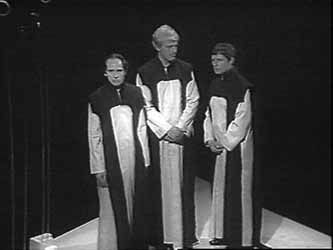 |
Given
their ruthless and nefarious methods, it's possible that Chris'
employers are members of the Celestial Intervention Agency.
After all, it was the CIA who assigned the Doctor to numerous
missions, including presumably the one in Genesis of the
Daleks (more on the role of that particular mission in
the lead-up to the Time War later...). So perhaps the abandoned
world shown in Dead Romance was not Gallifrey but the
adopted planet of a group of CIA members. However, Brax's
reference to his people retreating inside their bottle in
Twilight of the Gods goes against this theory, unless
Brax is mistaken or he is a member of the CIA.
Assuming
he isn't either of those things, why do the Time Lords lose
their bottle, so to speak? Maybe, following the fall of the
Gods of Dellah in Twilight
of the Gods, the Sphinxes demand the bottle's return and/or
evict the Time Lords, now that the threat is over. Alternatively,
perhaps the Time Lords, or at least a large proportion of
them, choose to reject the divine powers they have acquired.
It
is worth bearing mind that the webcast Death Comes to Time
suggests that all Time Lords innately possess and used
to exercise such abilities, but they set them aside because
of the damage they inadvertently caused to lesser beings.
It could be that some or all of the Time Lords, having forgotten
and/or lost the use of their mighty powers over the aeons,
are reminded of them and their dire consequences once inside
the bottle universe. Consequently, they leave as soon as they
deem it safe to do so. Events in Dead Romance might
also explain the relative lack of Time Lords in Death Comes
to Time - i.e. all but a few independent types could still
be inside the bottle at this point.
When General Tannis appears to wipe the Time Lords out, the
rest of them could actually be safe and sound inside their
bottle and emerge from it at a later date.
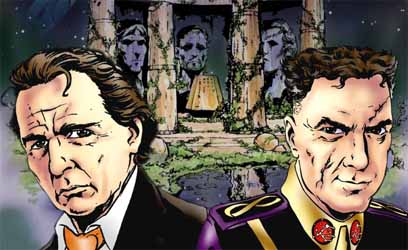 |
During
the build-up to the war against the unnamed Enemy mentioned
in several EDAs, the Time Lords once again seek a bottle -
this one made by I M Foreman - for use as a bolthole in case
the conflict goes badly. As to why they should seek a different
bottle than the one they used in Dead Romance, perhaps
the Sphinxes are less co-operative this time around, or maybe
Foreman's bottle is simply easier to obtain. In any event,
relatively few Gallifreyans enter this particular bottle,
which might indicate a newfound reluctance to abandon their
home universe and alter their physical natures, except as
a last resort.
The
Gallifrey Chronicles confirms that such bottles are not
unique (that is, that there is more than one of them in each
universe) by depicting a third. This bottled universe is used
by the Time Lord Marnal as a temporal monitoring system, owing
to its one-on-one correspondence with Marnal's universe.
It has been stated that the war against the Enemy (also known
as the War in Heaven) is not the same conflict as the Time
War of the new TV series. However, maybe there are connections.
At one stage it was rumoured that the Enemy would be revealed
to be the Daleks, but rights issues with the estate of Dalek
creator Terry Nation prevented that (as they almost thwarted
the monsters' return to the TV show).
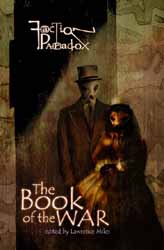 |
Mad
Norwegian Press' Faction Paradox: The Book of the War describes
the Enemy as: "Not so much an army as a hostile new kind of
history. So ambitious it can rewrite worlds..." The latter
phrase sounds not unlike the fallout of the Time War itself,
which appears to have left the structure of Time more delicate
and mutable than before. "Time's in flux," the Doctor explains
to Rose in The Unquiet Dead, "changing every second.
Your cosy little world can be rewritten like that!" In Father's
Day, the life or death of a single ordinary
human being changes the whole world. Like the War in Heaven,
the Time War is barely comprehended, if noticed at all, by
the lesser (i.e. non time-active) species.
The
Ancestor Cell shows the Enemy to be something else entirely.
According to the hypothesis of Greyjan the Sane, all life
in the universe is descended from a single ancestor cell.
However, this common ancestor was not the first life to develop.
Following the creation of the universe, various exotic life
forms existed, which either died out or were eradicated by
the Time Lords (as described in the NAs Sky Pirates! by
Dave Stone and Christmas on a Rational Planet by Lawrence
Miles). When the Time Lords stole Foreman's bottle universe
and hid it in the Time Vortex, it began to leak. The energy
nourished those early life forms, allowing them to grow and
adapt to an environment riddled with chronon decay and paradoxes
caused by time travel. According to Greyjan, these creatures
sidestepped millions of years of evolution and became the
Enemy.
However,
Greyjan is hardly a reliable source of information, and Lawrence
Miles not only disputes this theory but also dismisses Anghelides
and Cole's version of Faction Paradox as little more than
a parody. Certainly the Faction of The Ancestor Cell
have inexplicably transformed from the small but troublesome
voodoo cult of Miles' Alien Bodies and Interference,
and Jonathan Blum and Kate Orman's Unnatural History,
into a terrorist organisation powerful enough to conquer Gallifrey.
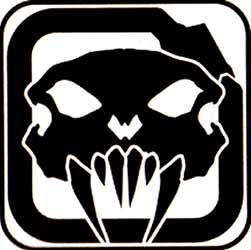 |
Miles
has suggested that the Faction members depicted in The
Ancestor Cell represent a degenerated far-future version
of the group. The Faction agents in Alien Bodies are
clearly from the Doctor's future rather than the Time Lord
present, because in their time the War in Heaven has already
started. The Faction in Interference also comes from
the future, therefore so must Mother Mathara, a character
who appears in both Interference and The Ancestor
Cell. The destruction of Gallifrey, according to Miles,
is caused by twisted yet powerful "late Faction" agents from
farther into the future, who are attempting to change the
accepted version of history and prevent the war, whereas everything
that happens in the Faction Paradox stories told by BBV, Mad
Norwegian Press and Magic Bullet is part of the "old order".
This old order might have been erased or shunted into an alternate
timeline by events in The Ancestor Cell, or maybe not,
depending on whether you wish to integrate the Faction Paradox
spin-offs into the same ongoing continuity as Doctor Who.
I have a theory that the Faction agents who invade Gallifrey
are tricked into doing so by the Enemy. With the war going
badly, perhaps the Enemy spreads disinformation about its
true nature (the "ancestor cell" theory) to a Faction Paradox
cell. Acting on this false intelligence, the agents travel
back in time, bringing about the apparent eradication Gallifrey
in the process. The object of the exercise, from the Enemy's
point of view, is to take Gallifrey out of the equation, paradoxically
ending the war before it has even begun.
This theory can also be applied if we assume that the Daleks
are the Enemy, or, if we wish to integrate the Faction Paradox
spin-offs as well, allied with the Enemy. The war could actually
be the Time War or, perhaps more likely, one of the Time Wars
that preceded it. Alternatively, The Book of the War
describes the Enemy as "a process" rather than "a single species,
or even a distinct political faction", so perhaps the Enemy
is the Time War itself: an aggressive process of historical
change that rewrites the universe, sweeping away the Time
Lords and the Daleks in its wake.
In
the episode Dalek, the Doctor refers to "the Last Great
Time War," which means there must have been others. It is
implied in various spin-off media that there have been several
previous Time Wars, but that all traces of them have been
removed from history. One such war is mentioned in the NA
Sky Pirates!, an ancient conflict fought between the
Time Lords and other races, including one known as the Charon.
In
three Doctor Who Monthly comic strips written by Alan
Moore, the Time Lords wage a Time War early in their history
against the Order of the Black Sun, which is based some 30,000
years in their future. The first strike of the war, from the
Gallifreyans' point of view, is when a Black Sun agent travels
back in time and attacks the Time Lords just as they are about
to turn the star Qqaba into a power source for their time
experiments. This also causes the apparent death of the solar
engineer Omega. The Time Lords do not know why the Black Sun
would wish to attack them, and theorise that it is in retaliation
for something they have yet to do (Star Death, DWM
#47, The 4-D War, DWM #51). Years later, at
a diplomatic conference, a representative of the Order is
murdered by the Sontarans, though the Time Lords are blamed.
This provides the motivation for the outbreak of war, since
from the Order's perspective, the Time Lords are the ones
who strike first (Black Sun Rising, DWM #57).
The
term "Time War" can be applied to at least two types of time-spanning
conflicts in the Doctor Who universe. The first type
occurs when two sides engage in conflict across different
points in history, as is the case with the war against the
Order of the Black Sun. The second type is where Time itself
is used as a weapon, with time loops, temporal paradoxes and
the reversal of historical events. The Time War of the 2005
series appears to be of the latter variety.
The Enemy's alleged "ancestor cell" disinformation strategy
seems to employ elements of both types: tricking a third party
into travelling back in time to effect a historical change.
 |
Panini's
Doctor Who Annual 2006 contains an article entitled
Meet the Doctor, written by Russell T Davies himself.
This article mentions two previous Time Wars, a skirmish between
the Halldons (a race mentioned in Terry Nation's We are
the Daleks story from the Radio Times 10th Anniversary
Special) and the Eternals (Enlightenment, Professor
Bernice Summerfield and the Heart's Desire),
and the brutal slaughter of the Omnicraven Uprising. On both
occasions, the Time Lords stepped in to settle matters. Despite
their policy of non-intervention, it is said that the Time
Lords regarded themselves - on a higher level, in affairs
of the Time Vortex - as keepers of the peace.
The
article describes the conflict between the Daleks and the
Time Lords as "the Great (and final) Time War". It was preceded
by numerous smaller clashes between the two races, including
a Dalek attempt to infiltrate the Time Lord High Council using
duplicates (in Resurrection
of the Daleks),
and an open declaration of hostility by "one of the Dalek
Puppet Emperors" (Davros in Remembrance
of the Daleks). However, the Daleks claimed
that these attacks were merely retaliation for the Time Lords
sending the Doctor back through Dalek history in an attempt
to commit genocide (in Genesis of the Daleks).
 |
It
is claimed that President Romana attempted to open a peace
treaty under "the Act of Master Restitution" (probably a reference
to the Master's trial on Skaro at the beginning of the Doctor
Who TV
movie, and possibly also an allusion to Romana's
assignment of the Doctor to retrieve the Master's remains
at the end of Lungbarrow). However, "the Etra Prime
Incident" (the audio drama The Apocalypse Element,
in which Romana is enslaved by the Daleks for twenty years)
triggered an escalation of hostilities.
Meet
the Doctor makes no mention of any other Big Finish audio
dramas featuring President Romana, such as Neverland
and Zagreus,
or the Gallifrey series. How do these fit into the
bigger picture, especially in view of the discrepancies that
exist between these stories and various novels, from both
the Virgin and BBC ranges, that have depicted Romana and others
as Gallifrey's President?
Romana
returns to Gallifrey from E-Space in the NA Blood Harvest,
written by Terrance Dicks. She succeeds Flavia as President
in Paul Cornell's Happy Endings and subsequently appears,
as does Leela, in the final Seventh Doctor NA, Lungbarrow.
However, when Dicks wrote the first of the BBC's EDAs, The
Eight Doctors, he overlooked events that had taken place
since his own Blood Harvest. Later EDAs - The Shadows
of Avalon, by Paul Cornell, and The Ancestor Cell -
returned Romana, in a regenerated form, to her seat of office,
so we can assume that The Eight Doctors takes place
before Happy Endings so far as Gallifrey is concerned.
Dialogue in The Apocalypse Element explicitly indicates
that it is possible (though apparently unusual) for Time Lords
to encounter one another out of temporal sequence.
So
far so good, but then Big Finish's Gallifrey-based audio dramas
began to deviate from the books that had gone before them.
In Zagreus, Romana and Leela appear to meet each other
for the first time. This might mean that the story takes place
before Lungbarrow, but then the Gallifrey spin-off
series gives Andred the familial House name of Deeptree, in
Chapter Five - Lies,
whereas Lungbarrow claimed it was Redlooms. Andred
dies in Chapter
Eight - Insurgency, without giving Leela the
child she carried in Lungbarrow. The final nail in
the coffin of continuity comes in Chapter
Nine - Imperiatrix, in which Leela's K9 (Mark
I) is destroyed.
However, it is possible that the Eighth Doctor audios, and
consequently the Gallifrey series that spun off from
them, all take place after the BBC's Eighth Doctor novels.
After all, we know that Gallifrey's existence is somehow restored
at some point between The Gallifrey Chronicles and
the Time War.
I
resisted such placement for a while, because I preferred to
assume that The Gallifrey Chronicles occurred close
to the end of the Eighth Doctor's lifetime, and I felt that
the notion of the planet being somehow "reset" to its pre-Lungbarrow
condition was too contrived. However, I have since warmed
to the idea, because though the Eighth Doctor novels ceased
publication more than a year ago, the Gallifrey audio
dramas are more recent and the Eighth Doctor's audio adventures
continue unabated. Therefore, it is more satisfying to treat
the audios as the newer adventures. This also allows the planet
to "live a little" between its two annihilations.
The
Gallifrey Chronicles reveals that, just prior to destroying
his home world, the Doctor, with the aid of his former companion
Compassion, downloaded the entire contents of the Matrix (the
vast computer network containing the mental traces of every
Time Lord living and dead) into his brain. His own memories
were suppressed to make room for the super-compressed data.
The planet had not actually been erased from history as believed.
Instead, an event horizon in relative time prevented anyone
from Gallifrey's past from travelling beyond the planet's
destruction, and vice versa. Both the planet and the Time
Lords could be restored, along with the Doctor's memory, if
a sufficiently sophisticated computer could be found to reconstruct
them.
Wisely (given that the TV show might reveal more information
about the Time War at some future date) author Lance Parkin
does not specify how Gallifrey is brought back into being
prior to the war. However, he provides plenty of clues as
to how this might be achieved. He reminds us that the companion
Fitz once died but was "remembered" back into existence using
Remote technology and with help from the TARDIS databanks
(Interference). In a flashback sequence that at first
glance appears to bear only a tenuous connection with the
rest of the narrative, Parkin also introduces the Network,
a gestalt of intelligent software that runs on humanoid brains
instead of computers. A combination of Remote, Network and
TARDIS technology, perhaps with the application of block transfer
computation (Logopolis), operating on a planetary scale,
could explain Gallifrey's resurrection.
 |
At
the end of The Gallifrey Chronicles, the Doctor sends
a K9 unit that has survived on board the TARDIS (almost certainly
Leela's K9 Mark I) to Espero, the planet he visited in Halflife,
probably to track down Madame Xing, who had offered to restore
his lost memories. Xing is widely believed to be Compassion,
the implication being that she wanted to restore the Doctor's
memories in order to effectively destroy the Time Lords, who
had once tried to enslave her. Presumably the Doctor wishes
to get his memories back after he has rebuilt Gallifrey (he
doesn't appear to have any gaps in his memory during the new
series), but getting them back from Compassion while still
restoring the Time Lords is likely to require some negotiation.
Alternatively, it is possible that the Doctor's memories are
restored when he regenerates into his ninth incarnation.
The
discrepancy of Andred's House name could be attributed to
a slight error in the data transfer, rather like the TARDIS
not putting Fitz back together exactly the same as before.
The apparent reversion of Gallifrey to a pre-Lungbarrow
state of affairs could be another error in the transfer. Or
it could indicate a deliberate bit of tweaking by the Doctor,
who, believing the War in Heaven to be over, returns the planet
to a happier and more hopeful time in its history, before
Romana regenerated into a more corrupt incarnation. Leela
is still without child in this version of Gallifrey, though
there are hints, in Imperiatrix, that she might one
day have carried Andred's child, in another life.
Such
a restoration could also explain how the Braxiatel on planetoid
KS-159 (in the Bernice Summerfield series) is able
to communicate with his "past" self in Gallifrey's future
(in the Gallifrey series), despite never having been
counted as one of the four elementals (Time Lords) that survived
the events of The Ancestor Cell.
 |
When
he leaves his home world, (as told in Chapter
Seven - Pandora), he actually leaves the restored
version of Gallifrey rather than the original one, and travels
back in time to appear in numerous Virgin and Big Finish adventures,
and to found his famous Collection (first mentioned in City
of Death). How he manages to traverse and communicate
across the temporal event horizon described in The Gallifrey
Chronicles may be because "restored" Gallifreyans are
somehow not affected by this barrier. Certainly Brax is a
wily and resourceful individual. Intriguingly, in Panacea,
the final chapter of the Gallifrey series, Braxiatel's
proposed solution for saving Gallifrey - by re-creating it
from stored bio-data - is markedly similar to the Eighth Doctor's
plan.
The
ultimate fate of Braxiatel remains unclear, however. It appears
that all of his Bernice Summerfield stories to date
take place prior to the Time War. Despite some suggestions
that the Time Lords might be back in residence on Gallifrey
by this juncture (in the audio adventure Death
and the Daleks,
Brax ponders the possibility of summoning the might of his
people to vanquish the Fifth Axis, while Simon Guerrier's
short story "Inappropriate Laughter", in the anthology Something
Changed, also seems to refer to Brax's civilisation
in the present tense), dialogue in the more recent audio drama
The
End of the World
indicates that "his lot" have not yet emerged from their bottle
universe. He informs Jason that: "They've gone their merry
way! They don't care - they never did."
However, it is possible that Braxiatel survived the Time War.
After all, he once transformed himself into an inanimate object,
the Stone of Barter (as revealed in The
Empire State).
Adopting a similarly dormant form could allow him to escape
the effects of the Time War and to evade telepathic detection,
just as the Master hid away by turning himself into a human
being (as revealed in Utopia).
Maybe Brax is even now biding his time, awaiting the opportunity
to restore the Time Lords once again...
According
to Big Finish's chronology, the Eighth Doctor's earliest encounter
with Romana in an audio adventure occurs during Shada.
The opening sequence of this story lends itself to the interpretation
that the Doctor is checking out his handiwork: the re-created
Gallifrey. It is also possible that the restoration of his
own memories is what dredged up that bit of unfinished business
from his fourth incarnation...
Unfortunately,
Gallifrey seems fated for a devastating war, albeit a civil
one in the first instance, while Romana appears destined for
corruption. Her ruthless attitude in Neverland echoes
that of her third incarnation in The Shadows of Avalon
and The Ancestor Cell. In later episodes of Gallifrey,
she is tempted by the Pandora entity.
Like
The Gallifrey Chronicles, the Gallifrey audio
series ends on a cliffhanger. This could mean that some kind
of continuation is due, or it could, as with Chronicles,
signify that it is up to the reader to imagine what happens
next. Like Lance Parkin before him, Panacea writer
Alan Barnes leaves us clues as to what might transpire. Possibly
informed by his experience of battling the Daleks in Death
and the Daleks, Braxiatel warns that something bad is
coming, a catastrophe far worse than anything the Time Lords
have previously encountered or even imagined. The planet and
its people are weakened and ripe for opportunist attack. The
Daleks get an explicit name check and Mephistopheles Arkadian
also mentions some "metal clients".
Ultimately,
of course, comes the Time War. According to Meet the Doctor,
the Time Lords use Bowships (mentioned in State of Decay),
Black Hole Carriers and N-Forms (from Russell T Davies' NA
Damaged Goods), while the Daleks unleash "the full
might of the Deathsmiths of Goth" (from the comic strip Black
Legacy by Alan Moore and David Lloyd, Doctor Who Weekly
#35-38).
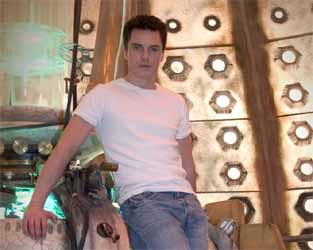 Dialogue
in The
Parting of the Ways suggests that the Daleks
consolidate their forces from throughout time as well as space.
Captain Jack states that: "One minute they're the greatest
threat in the universe, the next minute they vanished out
of time and space". To which the Doctor replies, "They went
off to fight a bigger war. The Time War." This is clearly
a violation of the Time Lords' much-vaunted Laws of Time,
but it also explains why, after the war, little or no trace
remains of the Dalek species at any point in history. In Dalek,
for example, the lone survivor scans the heavens of 2012 for
fellow creatures but finds none, even though we know Daleks
existed in a previous timeline. Dialogue
in The
Parting of the Ways suggests that the Daleks
consolidate their forces from throughout time as well as space.
Captain Jack states that: "One minute they're the greatest
threat in the universe, the next minute they vanished out
of time and space". To which the Doctor replies, "They went
off to fight a bigger war. The Time War." This is clearly
a violation of the Time Lords' much-vaunted Laws of Time,
but it also explains why, after the war, little or no trace
remains of the Dalek species at any point in history. In Dalek,
for example, the lone survivor scans the heavens of 2012 for
fellow creatures but finds none, even though we know Daleks
existed in a previous timeline.
According
to Meet the Doctor, the war goes on for several years.
It is waged in the Time Vortex and, beyond that, in "the Ultimate
Void" (whatever that is), but the conflict goes unnoticed
by the majority of intelligent races in the universe. The
timelines of the Lesser Species (intriguingly, Davies uses
the same term as Lawrence Miles) are occasionally altered
by damage to the Vortex, but the inhabitants of the worlds
affected remain unaware of the changes, because they were
a part of them. Only the Higher Species, those farther up
the evolutionary ladder, are able to perceive what is happening.
These include the tree people of Cheem (The End of the
World), who weep at the bloodshed; the Eternals, who flee
this reality, never to be heard from again; the Nestene Consciousness,
which loses all its planets and mutates under temporal stress
(thus explaining its change of appearance in Rose);
and the Greater Animus (The
Web Planet), which perishes.
In
The Sound of Drums, it is revealed that the Time Lords
somehow resurrect the Master in order for him to fight for
them as a warrior. However, he flees in terror before the
conclusion of the war, after the "Dalek Emperor took control
of the Cruciform". Taking on human form, he hides himself
at the time of the universe's heat death, where no Time Lord
had ever ventured before.
 Just
one man walks free from the ruins of Gallifrey: the Doctor.
Evidence suggests that the Time Lord himself causes the planet's
destruction, probably under desperate circumstances similar
to those in which he found himself at the end of The Ancestor
Cell. In
Dalek, he claims that he was responsible for the devastating
conflagration that wiped out the Daleks: "I made it happen,"
but he also states that the Time Lords "burned with" them.
In The
Impossible Planet, the Beast refers to the
Doctor as a "killer of his own kind". Just
one man walks free from the ruins of Gallifrey: the Doctor.
Evidence suggests that the Time Lord himself causes the planet's
destruction, probably under desperate circumstances similar
to those in which he found himself at the end of The Ancestor
Cell. In
Dalek, he claims that he was responsible for the devastating
conflagration that wiped out the Daleks: "I made it happen,"
but he also states that the Time Lords "burned with" them.
In The
Impossible Planet, the Beast refers to the
Doctor as a "killer of his own kind".
At some point between the Eighth Doctor audios and Rose,
the Doctor evidently regenerates, though the circumstances
of this event have yet to be documented. It is tempting to
assume that the Eighth Doctor meets his end heroically defending
the innocent during the Time War. A scene in Rose in
which the Doctor looks in a mirror and declares: "Could have
been worse. Look at the ears," suggests that he has only recently
changed. However, the Ninth Doctor must have been around long
enough for Clive to amass all his documentary evidence of
this incarnation's solo travels. It's possible that the Doctor
regenerated quite some time ago but, owing to his guilt over
his actions in the war, he had been unable to face his own
reflection until now. This could be part of the overall process
of rehabilitation that we see taking place over the course
of the 2005 series of Doctor Who.
The
TARDIS interior also undergoes a change during this time.
The Gallifrey Chronicles suggests that the ship's new,
less cluttered look in Rose is the result of damage.
A fusion device detonates inside the vessel, destroying its
contents, including bric-a-brac observed during various previous
adventures: the books and the bookshelves, the antique furniture,
the candles, the kitchen, the food machine, the fault locator,
the lamps, the hat stand, the shaving mirror, the carpets,
the ormulu clock, the full-length mirror, the tea set, the
wine rack, the chess sets, the gramophone, the butterflies,
the tool kit and the cuddly toys. The TARDIS swimming pool
is boiled dry, the ivy in the cloisters is vaporised and a
wardrobe the size of an aircraft hanger is burned clean. Fitz's
room, including all of his records and souvenirs, are also
incinerated. The actual fabric of the TARDIS is largely undamaged
and is able to repair itself.
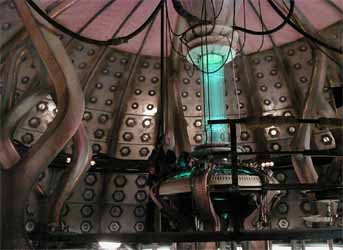 |
However,
the Eighth Doctor audios, which I have placed after The
Gallifrey Chronicles, reflect the sounds and (on their
back covers) the look of the TV movie interior. Furthermore,
the novels had already deviated from this design. When the
TARDIS is restored at the end of Escape
Velocity, it appears more cosy and homely than
its previous cathedral-like look, with wooden roundels on
the walls and a replica of the kitchen from the Doctor's house
in Kent.
It would seem that the TV movie version of the ship's interior
has come and gone before. The Big Finish audio drama The
Settling suggests - rather contentiously -
that the Seventh Doctor redecorates his vessel immediately
prior to that story, which uses sound effects from the TV
movie. This contradicts several other stories: practically
the whole of the NA
series; Gary Russell's novelisation of the movie; and even
Big Finish's own The Sirens of Time, which uses 1980s-style
TARDIS sounds. I theorise that the Settling makeover
is a temporary one and that the vessel, perhaps accidentally,
reverts to its white décor at some point prior to the NAs.
Similarly,
it could be that the TV movie look is something that the TARDIS
can return to quite easily. Perhaps, having accidentally lost
the design prior to the NAs, and having gradually and painstakingly
re-created it before the TV movie, the Doctor saves the pattern,
rather like a restore point on a computer. This could explain
its reversion between The Gallifrey Chronicles and
the Eighth Doctor audios. The ship's new look from Rose
onwards could indicate battle damage incurred during the war,
the non-availability of Gallifreyan spare parts, or simply
the Doctor's desire for a change.
When
Rose Tyler joins him on board the TARDIS, the lonely wanderer
finally begins to recover from the trauma of his experiences.
The last of the Time Lords is no longer alone...
Below
is a speculative chronology of the major events in recent
Gallifreyan history, taking into account the television series,
Virgin New Adventures, BBC Books novels, Big Finish
audio dramas and Doctor Who Magazine comic strips.
Blood
Harvest (Virgin Books) Flavia is President. Romana
returns to Gallifrey.
The Eight Doctors (BBC Books)
Romana succeeds Flavia as President.
Happy Endings Romana meets
the Doctor out of sequence.
Lungbarrow Romana meets the
Doctor out of sequence. She assigns him to collect the Master's
remains in...
Doctor Who (TV movie)
Romana vanishes on Etra Prime (see The
Apocalypse Element). She is replaced by a retired
male President (possibly Niroc from The
Eight Doctors).
The Final Chapter (DWM)
The Sirens of Time (Big Finish)
Where Angels Fear (Virgin Books)
The Gods of Dellah rise.
Dead Romance (Virgin Books)
The Time Lords obtain a bottled universe from the Sphinxes,
intending to use it to escape the Gods.
Tears of the Oracle (Virgin
Books)
The majority of the Time Lords escape within the Sphinxes'
bottle.
Death Comes to Time (BBCi webcast/BBC
Audio) The few Time Lords remaining in their own universe
are wiped out by Tannis.
Twilight of the Gods (Virgin
Books) The Gods of Dellah fall.
The Time Lords emerge from the bottle universe. Afterwards,
they lose access to the bottle (perhaps the Sphinxes become
less co-operative). During the Time Lords' absence, the
Daleks have grown more powerful...
The Apocalypse Element (Big
Finish) Romana returns. She meets the Doctor out of sequence.
Interference (BBC Books) Fearing
another war, this time against the unnamed Enemy, the Time
Lords steal Foreman's bottle.
Romana regenerates.
The Shadows of Avalon (BBC
Books)
The Banquo Legacy (BBC Books)
The Ancestor Cell (BBC Books)
Gallifrey is apparently destroyed.
The Gallifrey Chronicles (BBC
Books)
Gallifrey is restored, probably using a combination of Remote,
Network and TARDIS technology. The planet reverts to a pre-Lungbarrow
state, due to an error in the transfer or deliberate tweaking
by the Doctor.
Shada
(Big Finish)
Neverland (Big Finish)
Zagreus (Big Finish)
The Gallifrey series (Big Finish)
The War in Heaven and/or the Time War is waged. Perhaps
the two are synonymous, or perhaps one follows the other.
Gallifrey is destroyed.
I
am indebted to the online resources provided by the Doctor
Who Reference Guide (www.drwhoguide.com), Outpost Gallifrey's
Canon-Keeper's Guide to Doctor Who (www.gallifreyone.com/guides-canon.php),
the Whoniverse's Discontinuity Guide (www.whoniverse.org/discontinuity)
and the wonderful Wikipedia.

Return
to

|